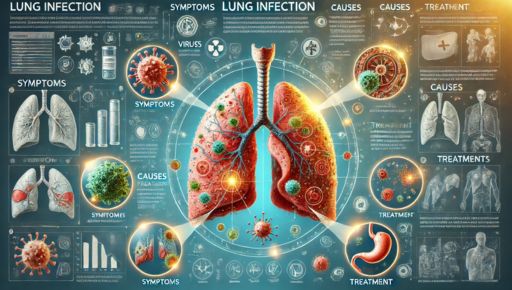Health
Understanding Lungs Infection: Symptoms, Causes, and Treatment Options

Introduction: What is a Lungs Infection?
A lungs infection refers to any infection that affects the lungs, causing inflammation, difficulty breathing, and other associated symptoms. Lungs infections can range from mild to severe and, in some cases, can lead to life-threatening conditions. The lungs, which are vital organs in the respiratory system, are responsible for the exchange of oxygen and carbon dioxide. Any disruption in their function due to infection can have serious health implications. In this article, we will explore the various types of lungs infections, their symptoms, causes, and available treatment options.
Types of Lungs Infections
There are different types of lungs infection that can affect individuals. These infections vary in severity, causes, and treatment approaches. The most common types include:
- Pneumonia: Pneumonia is one of the most prevalent and serious types of lung infections. It occurs when the air sacs in one or both lungs become inflamed and filled with fluid or pus. This infection can be caused by bacteria, viruses, or fungi. Bacterial pneumonia is often treated with antibiotics, while viral pneumonia may require antiviral medications or supportive care.
- Bronchitis: Acute bronchitis is another form of lungs infection that primarily affects the bronchial tubes. These tubes carry air to your lungs. Acute bronchitis is usually caused by viral infections, and while it can lead to coughing, chest discomfort, and fatigue, it typically resolves on its own. Chronic bronchitis, often associated with smoking or prolonged exposure to irritants, can lead to long-term damage to the lungs.
- Tuberculosis (TB): Lungs infection caused by tuberculosis (TB) is a bacterial infection that affects the lungs. TB is highly contagious and spreads through the air when an infected person coughs or sneezes. Early detection and treatment are essential to prevent serious complications and further transmission. TB requires long-term treatment with antibiotics.
- Asthma and Respiratory Infections: While asthma itself is not typically considered an infection, individuals with asthma are more prone to lungs infections like pneumonia or bronchitis. Asthma can increase inflammation in the lungs, making them more vulnerable to bacterial or viral infections. Managing asthma symptoms effectively can reduce the risk of secondary infections.
Symptoms of Lungs Infection
The symptoms of a lungs infection can vary based on the type and severity of the infection. However, some common symptoms include:
- Coughing: A persistent cough that may produce mucus or phlegm is one of the most common symptoms of lung infections.
- Shortness of Breath: Difficulty breathing or feeling winded after minimal physical activity can indicate a serious lung infection.
- Chest Pain: People with lung infections often experience chest discomfort, which may worsen when breathing deeply or coughing.
- Fever and Chills: An infection often triggers the body’s immune response, leading to fever, chills, and sweating.
- Fatigue: Constant tiredness or a general feeling of weakness is common during lung infections.
- Wheezing: Wheezing or a high-pitched whistling sound when breathing is another symptom often associated with bronchitis and asthma-related infections.
- Bluish Lips or Fingernails: In severe cases of lung infection, oxygen levels may drop, resulting in a bluish tint to the lips or nails.
If you experience any of these symptoms, especially shortness of breath or chest pain, it is important to seek medical attention immediately.
Causes of Lungs Infection
The causes of lungs infection can be categorized into various factors, including viruses, bacteria, and fungi. Here are some common causes:
- Viruses: Many lungs infections are caused by viral infections, such as the flu, respiratory syncytial virus (RSV), and coronaviruses. These viruses attack the respiratory system, leading to inflammation and other symptoms. Viral infections are highly contagious and can spread easily from person to person.
- Bacteria: Bacterial infections like pneumonia or bronchitis are caused by harmful bacteria that infect the lungs. Bacteria can enter the lungs through inhalation or from an infection in another part of the body, such as the sinuses. Streptococcus pneumoniae and Haemophilus influenzae are some common bacterial pathogens responsible for lungs infections.
- Fungi: Fungal infections, though less common, can also cause lungs infections. Fungi such as Histoplasma, Coccidioides, and Aspergillus can infect the lungs, especially in individuals with weakened immune systems. These infections are more common in specific regions or environments, such as areas with certain types of soil or during exposure to bird droppings.
- Environmental Factors: Exposure to certain environmental factors, including smoke, air pollution, and chemicals, can also increase the risk of developing lungs infections. People with chronic lung diseases like asthma or COPD (chronic obstructive pulmonary disease) are especially susceptible.
- Weakened Immune System: Individuals with a weakened immune system, such as those with HIV/AIDS or those on immunosuppressive medications, are more prone to developing infections, including lungs infections.
Risk Factors for Lungs Infection
Certain factors can increase the risk of developing a lungs infection. These include:
- Age: The very young and the elderly are more susceptible to lungs infections due to weaker immune systems.
- Smoking: Smoking damages the airways and lungs, making them more vulnerable to infections.
- Pre-existing Health Conditions: Conditions like asthma, diabetes, and heart disease can increase the likelihood of lung infections.
- Poor Hygiene: Poor hand hygiene and exposure to crowded environments can increase the risk of viral and bacterial infections.
- Weak Immune System: Individuals with conditions like HIV/AIDS or those undergoing chemotherapy may have a compromised immune system, making them more susceptible to infections.
Treatment for Lungs Infection
The treatment for lungs infections depends on the underlying cause and severity of the infection. Here are the main treatment options:
- Antibiotics: If a bacterial infection is diagnosed, antibiotics will be prescribed to help combat the infection. It is important to complete the entire course of antibiotics, even if symptoms improve, to ensure the infection is fully eradicated.
- Antiviral Medications: For viral infections like the flu or RSV, antiviral medications may be prescribed to reduce the severity of symptoms. However, in many cases, viral infections are self-limiting and may only require supportive care.
- Supportive Care: For mild cases, treatment may involve supportive care, including rest, fluids, and over-the-counter medications to relieve symptoms like fever and coughing.
- Hospitalization: Severe cases of lungs infection, such as pneumonia or tuberculosis, may require hospitalization. In the hospital, patients may receive oxygen therapy, intravenous antibiotics, and other forms of intensive care.
- Vaccines: Vaccines are available for certain infections that affect the lungs, such as pneumonia and the flu. Vaccination can help prevent infections and reduce the risk of complications.
Prevention of Lungs Infection
Preventing a lungs infection involves a combination of lifestyle habits and preventive measures. Some key tips include:
- Practice Good Hygiene: Wash hands frequently and avoid close contact with sick individuals.
- Quit Smoking: Smoking cessation reduces the risk of lung damage and infections.
- Get Vaccinated: Vaccines for influenza, pneumonia, and other respiratory infections can prevent many lung-related infections.
- Boost Your Immune System: A healthy diet, regular exercise, and adequate sleep help strengthen the immune system.
- Avoid Exposure to Pollutants: Minimize exposure to secondhand smoke, air pollution, and harmful chemicals.
Conclusion
A lungs infection can significantly impact your respiratory health and overall well-being. Recognizing the symptoms early, understanding the causes, and seeking appropriate treatment are essential for effective management. While most lungs infections are treatable, some can lead to complications if left untreated. By following preventive measures and maintaining a healthy lifestyle, you can reduce the risk of developing lung infections and promote better respiratory health. If you suspect you have a lungs infection, consult with a healthcare professional to determine the best course of action for your condition.
Health
Discover the Best Urology Hospital in Bangalore for Expert Care and Compassionate Treatment
When it comes to urological health, early diagnosis and specialised treatment make a world of difference. Bangalore, often hailed as the healthcare capital of India, offers a range of advanced medical facilities. Among these, some hospitals stand out for their state-of-the-art equipment, highly experienced doctors, and a patient-first approach. If you’re searching for a urology hospital in bangalore, that blends technology with compassion, you’re in the right place.
Why Choose a Urology Hospital in Bangalore?
Bangalore is home to several multispeciality hospitals and specialised urology centres that offer comprehensive services ranging from minor consultations to complex surgeries. These hospitals cater to a variety of urological conditions including:
- Kidney stones
- Urinary tract infections (UTIs)
- Prostate enlargement
- Male infertility
- Incontinence
- Bladder cancer
- Erectile dysfunction
Most top hospitals in Bangalore use minimally invasive techniques such as laparoscopy and laser treatment, ensuring faster recovery and minimal discomfort.
Cutting-Edge Technology Meets Patient-Centred Care
What sets apart the best urology hospitals in Bangalore is not just the availability of advanced medical technology, but the integration of that technology with patient-focused care. From 3D laparoscopic surgeries to robotic-assisted procedures, these hospitals are redefining how urological treatments are delivered in India.
Moreover, many of these hospitals are NABH-accredited, which ensures strict adherence to quality standards in treatment and hygiene. International patients often prefer Bangalore due to world-class infrastructure at a fraction of the cost compared to Western countries.
What to Expect from the Best Urology Hospital in Bangalore
Finding the best urology hospital in bangalore involves more than just looking at the number of surgeries performed. Here’s what you should expect:
- Specialised Urologists: Doctors with decades of experience and super-specialisation in areas like andrology, uro-oncology, paediatric urology, and reconstructive urology.
- Comprehensive Diagnosis: High-end diagnostic tools like uroflowmetry, urodynamic studies, CT urography, and digital cystoscopy.
- Tailored Treatments: Each patient is given a customised treatment plan. This ensures not just successful outcomes, but also minimal side effects.
- Privacy & Comfort: Urological problems can be sensitive. The best hospitals in Bangalore offer private consultation rooms and a discreet treatment environment.
- Post-Surgery Support: From diet plans to physiotherapy and regular follow-ups, recovery support is an essential part of the process.
Popular Urology Procedures Offered in Bangalore
Some of the most commonly performed urological procedures in Bangalore include:
- TURP (Transurethral Resection of the Prostate)
- PCNL (Percutaneous Nephrolithotomy)
- Ureteroscopy
- Lithotripsy
- Circumcision
- Vasectomy and reversal
- Bladder augmentation
- Robotic radical prostatectomy
Most procedures are performed using advanced tools and techniques, ensuring quicker recovery times and minimal hospital stay.
Choosing the Right Hospital: What Patients Say
Patient testimonials often point to a few hospitals as being the most trustworthy in terms of care, affordability, and outcome. Many families express gratitude for the detailed counselling, clear communication, and round-the-clock support they received. Some hospitals also offer online consultations and second opinions for those living outside Bangalore or abroad.
Final Thoughts
Your urological health deserves the best attention and expertise. Bangalore offers a perfect blend of modern medical technology, compassionate care, and affordability. Whether it’s a routine check-up or a complex surgery, choosing a reputed hospital ensures you’re in safe hands.
Health
Top-Rated Heart Hospital in Hyderabad: Your Guide to the Best Cardiology Care
Hyderabad, a bustling hub of healthcare innovation, has earned its place as a destination for world-class heart treatment. From advanced cardiac procedures to compassionate patient care, the city is home to some of the most renowned hospitals in India. Whether you’re seeking routine cardiology consultations or complex heart surgeries, Hyderabad’s heart hospitals offer a perfect blend of modern technology and experienced specialists.
In this article, we explore what makes the city a leading heart care destination and help you discover the Heart Hospital in Hyderabad for your needs.
Why Choose a Heart Hospital in Hyderabad?
Hyderabad has grown to become one of India’s top healthcare destinations, especially for cardiac care. Here’s why:
- World-Class Infrastructure: Heart hospitals in Hyderabad are equipped with cutting-edge technology like robotic surgery systems, advanced cath labs, 3D imaging, and hybrid operating rooms.
- Highly Skilled Cardiologists: Many cardiologists and cardiac surgeons practicing in Hyderabad are globally trained and have decades of experience treating critical heart conditions.
- Affordable Yet Quality Care: Compared to Western countries, and even some Indian metros, Hyderabad offers cost-effective cardiac treatments without compromising on quality.
- Global Patient Footfall: Patients from across the globe — especially from Africa, the Middle East, and neighboring South Asian countries — visit Hyderabad for heart treatment, thanks to its high success rates and warm hospitality.
Services Offered by Top Heart Hospitals
The leading best cardiology hospital in hyderabad will typically provide a wide spectrum of services under one roof. These include:
- Preventive Cardiology: Early detection and lifestyle counseling to manage risk factors like hypertension, cholesterol, and diabetes.
- Interventional Cardiology: Non-surgical treatments such as angioplasty, stenting, and catheter-based procedures.
- Cardiac Surgery: Bypass surgeries (CABG), valve replacements, congenital heart defect repairs, and minimally invasive heart surgeries.
- Electrophysiology: Treatment for rhythm disorders, pacemaker or ICD implantation, and ablation procedures.
- Rehabilitation & Follow-up Care: Cardiac rehab programs for recovery, lifestyle change, and long-term heart health.
These hospitals are also equipped to handle cardiac emergencies 24/7, with rapid response units and ICU care.
How to Choose the Right Hospital?
Choosing the right hospital can be a life-changing decision. Keep these factors in mind:
- Experience and Reputation: Check for hospitals with a track record of high success rates and experienced cardiac teams.
- Technology and Facilities: Look for NABH/JCI accreditation, modern operation theatres, and advanced diagnostic labs.
- Patient Testimonials: Real-life stories often reflect the hospital’s commitment to care and successful recovery journeys.
- Location and Accessibility: Choose a hospital that’s easily reachable in case of emergencies.
- Cost and Insurance Support: Transparent pricing and insurance partnerships make treatment smoother.
Notable Heart Hospitals in Hyderabad
Here are some of the reputed names in the field of cardiology in Hyderabad:
- Apollo Hospitals, Jubilee Hills: Known for its pioneering work in cardiac care, including robotic surgeries and heart transplants.
- CARE Hospitals, Banjara Hills: Offers comprehensive cardiac treatments and is known for high success rates in angioplasty and bypass surgeries.
- Yashoda Hospitals: Equipped with advanced diagnostic and surgical facilities, and experienced in both pediatric and adult cardiology.
- KIMS Hospitals, Secunderabad: A preferred center for heart patients looking for affordable, high-end cardiac procedures.
Each of these hospitals is supported by world-class infrastructure, round-the-clock care, and experienced cardiologists, making them top choices for heart treatment in the city.
Final Thoughts
If you or your loved ones are dealing with a heart-related condition, you’re in safe hands in Hyderabad. The city continues to lead the way in cardiac healthcare, combining compassion, innovation, and excellence.
Health
Managing Nerve Pain: Diagnosis and Treatments

What is nerve pain?
Nerve pain can be one of the most uncomfortable and frustrating health issues to deal with. The sensation is often described as burning, stabbing, shooting or a combination of all three. The pain may be chronic, or come and go. This pain occurs as a result of damage or irritation to the nerves of your body and can arise from injuries, medical conditions such as diabetes, infections, and even in some cases following surgery.
Getting the right diagnosis
The next step for most anyone suffering with nerve pain are the next steps to getting properly diagnosed. Many people suffer with pain for years without ever knowing the cause. The way doctors look for the cause of nerve pain is to first perform a physical examination and then start with a discussion about the pain. They are usually interested in when it started, what makes it better or worse, and whether you have other medical problems. They usually do blood work, nerve studies, and/or scans like CAT or MRI to help find the cause of your pain.
Pain management specialist
If they identify a cause they will begin to help you to put together a plan of treatment. And this is when a pain management specialist can really help you. Pain management doctors help to reduce pain and improve quality of life through medical treatment. They use both medicine and patient-centered approaches like behavioral social and emotional support, in decisions related to care. They will work to find the most efficacious treatment options for you.
Treatment Approaches for Nerve Pain
Treatment options for nerve pain may include medication. Some medications decrease nerve sensitivity, while others decrease swelling or muscle spasms. Physical therapy is commonly prescribed to increase strength and flexibility, and lessen pain as time goes on.
For some patients, advanced treatment options with injections, nerve blocks, or electrical nerve stimulation can provide great pain relief. These treatments directly target the affected nerve areas where the pain signals originate, and calm them down. If the pain is due to nerve compression/damage that can be repaired, then surgery may be considered.
Lifestyle Changes That Support Relief
Lifestyle changes also help manage neck pain. Some lifestyle changes that can be helpful include regular gentle exercise, good diet, and good sleep habits. Decreasing stress with activities such as meditation, yoga, or listening to music can be beneficial as stress will generally intensify the pain experience.
Acting early
It’s important to keep in mind that nerve pain will not (may not) go away entirely, but, if it is taken care of appropriately, it can be managed effectively. Early assessment and a customized treatment plan can provide the ability to prevent the pain from worsening and continue on with your daily activities.
If you experience ongoing pain, which does not go away, you should get advice for an assessment. You should not ignore the symptoms or wait too long before getting help to manage them. The earlier you act, the better your chance of finding relief and preserving your nerve health.
